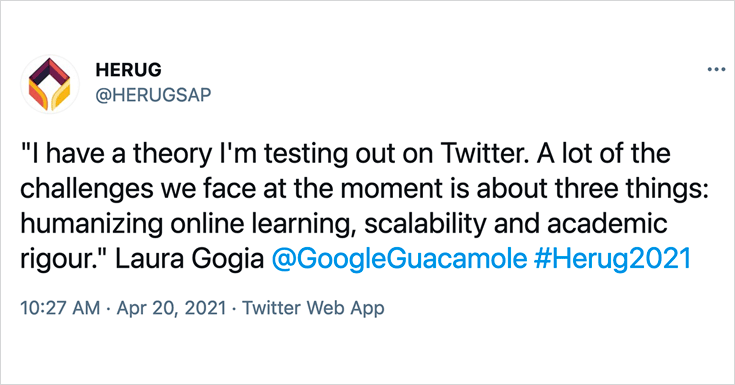The Iron Triangle of Ed-Tech
Former Analyst

Last week, I had the privilege to participate in a panel discussion at the 23rd International Conference of the SAP Higher Education and Research User Group. Joined by Jose Escamilla (Tecnologico de Monterrey), Malcolm Woodfield (SAP), and moderator Jill Mikros (The Johns Hopkins University), the panel explored the impact of COVID on higher education pedagogy and educational technologies. The perspectives were varied and the conversation lively. Somewhere in the middle, I said, “I have a theory I’m testing out on Twitter. A lot of the challenges we face at the moment is [sic] about three things: humanizing online learning, scalability, and academic rigor.”
Grammatical errors aside, the idea stuck with me. After tossing it around with academic Twitter, I realized that I had stumbled across the iron triangle of online learning. Conventional wisdom tells us that it’s possible to achieve two variables of an iron triangle but usually at the expense of the third. Humanization, scalability, and rigor are the variables we are currently holding in tension, and they are driving the discussion on online learning.1
The Sides of the Triangle
I’ve written previously on humanizing online learning, a concept that resonated with faculty and students (and society as a whole) in the social isolation of quarantine. As the pandemic progressed, the discourse on humanizing online learning expanded to all teaching and learning. Society reflected on the need to reevaluate workplace and academic expectations in the context of widespread struggle and loss.
In contrast, scalability has always been top-of-mind in the online learning discourse because many administrators and policy-makers perceive online programming as a growth strategy for increasing enrollment at a lower price point.2 Definitions of scale vary by context, ranging from several hundred to several thousand students in mega online classes and MOOCs (Massive Open Online Courses). However, many faculty equate scale of any kind to higher student-to-faculty ratios and an overdependence on automated workflows resulting in decreased student engagement, learning, and success.
Finally, online courses of any size (but particularly online courses at scale) have a complex relationship with academic rigor. While research indicates that online coursework can be equally or more rigorous than in-person coursework, many faculty perceive it as less rigorous and less effective. The causes of this perception problem are multifactorial and reflect inconsistent implementation, faculty inexperience with online learning, and—occasionally—elitism. Early reports suggest that the forced exposure to online learning during the pandemic increased faculty confidence in the approach, but approximately half of instructors still perceive it as inferior to in-person coursework.
Related COVID Controversies
The troubles associated with the iron triangle began long before COVID-19, but the conditions of the last year have increased their scope, visibility, and feeling of urgency. Examine the following hot topics from the collective discourse viewed through the lenses of humanization, scalability, and rigor.
Webcam Enforcement
Synchronous learning via videoconferencing (“Zoom School,” colloquially) dominated the early stages of remote instruction. Its adoption reflected faculty assumptions that real-time, face-to-face contact is the best approach for meaningful student engagement and teaching.
Initially, scaling was not an issue, although many institutions eventually encountered overages for cloud storage from recording and storing every class session. However, almost immediately, students refused to turn on their webcams for Zoom School. Some faculty lamented what they perceived as the dehumanizing impact of talking to black boxes rather than students’ faces. Faculty were also concerned about academic rigor, since they could not gauge attention or attendance as they would in physical classrooms. When faculty required students to turn on their cameras, student advocates called it dehumanizing and unnecessary surveillance of students (or “Zoom Gaze”).
Online Proctoring
During COVID-19, online proctoring products were sold—and eagerly bought by many institutions—as tools to support academic rigor at scale in online learning environments. Reports of widespread student cheating during remote instruction heightened concerns related to the rigor of online coursework and seemed to reinforce the need for student surveillance. However, the use of online proctoring technologies at scale has also raised questions about their accessibility, effectiveness, security, and fairness. (I address these issues most directly in this blog post). Some institutions are distancing themselves from online proctoring technologies and encouraging faculty to consider alternatives to high-stakes testing. These alternatives tend to be less scalable unless instructors have access to teaching assistants or can successfully implement peer- and self-assessment.
Insights and Analytics
Learning analytics were designed to shed light on student behaviors that might impact their ability to perform successfully in a course of study or a learning environment. The amount of time spent on learning tasks, in a platform, or with an assessment are examples of typical learning analytics. Student success management platforms might also focus on final grades and course load. The purpose of the data collection and associated dashboards is to help target student outreach and coaching efforts to students who need them the most—while intervention can still make a difference. These automated workflows ostensibly support high-touch support at scale, but their efficacy and potential impact on equity frequently called into question.
A Call to Action
The tensions between humanization, scale, and rigor will not disappear when institutions reopen and students return to campus. IT leaders must use their unique position in the post-COVID landscape to surface the triangle, helping to transcend institutional illogics and stymied debates. Consider the following examples, which promise to be common at institutions over the next year.
- Surveillance or support? Too many institutions and technology vendors collect and use student data without fully considering its efficacy, risk, or impact on the student experience. Campus IT leaders can challenge others to consider what constitutes student surveillance versus student support within their institutional context—thereby helping to prevent their institutions from crossing the line.
- Humanizing for whom? Although most institutions claim to be student-centered, it’s so easy to slip into traditional instructor-centric paradigms. For example, webcam enforcement has more to do with supporting a positive instructor experience than a positive student experience. The argument easily extends to geolocation attendance policing with classroom response systems. Campus IT leaders can use their leadership positions to reframe the conversation so that it reflects the student perspective. They can also advocate for faculty development and instructional design support to find alternative approaches that feel humanizing for everyone.
- How are we making informed decisions? Historically, IT leaders have taken a hands-off approach or a supporting role regarding decisions about teaching and learning. The teaching and learning landscape has changed. The deep integration of learning technologies in higher education offers great pedagogical promise but also incurs unique risks to student privacy, equity, and security. IT leaders must play a more significant role in decisions about educational technologies and how they are used on campus than they have in the past.
1 Special thanks to Dr. Jon Becker, associate professor of educational leadership at Virginia Commonwealth University. He was instrumental in helping me think aloud about this post on Twitter, identifying my three variables as an “iron triangle” and pointing me towards a fascinating essay on institutional illogics.
2 While the 2018 joint study by Arizona State University Foundation and The Boston Consulting Group indicates that online learning can achieve a higher ROI, it is not an automatic state of things.
Categories
- Academic Administration
- Advancement
- AI and ML
- Content Management
- CRM Platforms
- Customer Experience (CX)
- Cybersecurity
- Data Management and Analytics
- Enterprise Portals and Mobile Apps
- Event Management
- Finance
- HCM/HR
- IT Tools and Infrastructure
- Life at Tambellini
- Services
- Student
- Teaching and Learning
- Technology Leadership
- Thought Leadership
- Uncategorized
Share Article:

Other Posts From this Author:
© Copyright 2025, The Tambellini Group. All Rights Reserved.